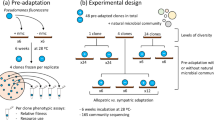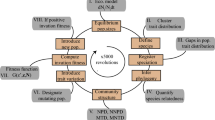Abstract
Taxonomic diversification commonly occurs through adaptive radiation, the rapid evolution of a single lineage into a range of genotypes or species each adapted to a different ecological niche1,2. Radiation size (measured as the number of new types) varies widely between phylogenetically distinct taxa2,3,4 and between replicate radiations within a single taxon where the ecological opportunities available seem to be identical5,6. Here we show how variation in energy input (productivity) and environmental disturbance combine to determine the extent of diversification in a single radiating lineage of Pseudomonas fluorescens adapting to laboratory conditions. Diversity peaked at intermediate rates of both productivity and disturbance and declined towards the extremes in a manner reminiscent of well-known ecological patterns7,8,9. The mechanism responsible for the decrease in diversity arises from pleiotropic fitness costs associated with niche specialization10,11, the effects of which are modulated by gradients of productivity and disturbance. Our results indicate that ecological gradients may constrain the size of adaptive radiations, even in the presence of the strong diversifying selection associated with ecological opportunity, by decoupling evolutionary diversification from ecological coexistence.
This is a preview of subscription content, access via your institution
Access options
Subscribe to this journal
Receive 51 print issues and online access
$199.00 per year
only $3.90 per issue
Buy this article
- Purchase on Springer Link
- Instant access to full article PDF
Prices may be subject to local taxes which are calculated during checkout



Similar content being viewed by others
References
Simpson, G. G. The Major Features of Evolution (Columbia Univ. Press, New York, 1953)
Schluter, D. The Ecology of Adaptive Radiation (Oxford Univ. Press, Oxford, 2000)
Givnish, T. J. in Molecular Evolution and Adaptive Radiation (eds Givnish, T. J. & Sytsma, K. J.) 1–54 (Cambridge Univ. Press, Cambridge, 1997)
Conway Morris, S. in Evolution of Biological Diversity (eds Magurran, A. E. & May, R. M.) 283–321 (Oxford Univ. Press, Oxford, 1999)
Meyer, A. Phylogenetic relationships and evolutionary processes in East African cichlid fishes. Trends Ecol. Evol. 8, 267–305 (1993)
Williams, E. E. The origin of faunas—evolution of lizard congeners in a complex island fauna: a trail analysis. Evol. Biol. 6, 47–89 (1972)
Rosenzweig, M. L. Species Diversity in Space and Time (Cambridge Univ. Press, Cambridge, 1995)
Huston, M. A. Biological Diversity (Cambridge Univ. Press, Cambridge, 1994)
Connell, J. H. Diversity in tropical rainforests and coral reefs. Science 199, 1302–1310 (1978)
Maclean, R. C., Bell, G. & Rainey, P. B. The evolution of a pleiotropic fitness trade-off in Pseudomonas fluorescens. Proc. Natl Acad. Sci. USA 101, 8072–8077 (2004)
Rainey, P. B. & Travisano, M. Adaptive radiation in a heterogeneous environment. Nature 394, 69–72 (1998)
Day, T. & Young, K. A. Competitive and facilitative evolutionary diversification. Bioscience 54, 101–109 (2004)
Seehausen, O., van Alphen, J. J. M. & Witt, F. Cichlid fish diversity threatened by eutrophication that curbs sexual selection. Science 277, 1808–1811 (1997)
Losos, J. B. & Schluter, D. Analysis of an evolutionary species-area relationship. Nature 408, 847–850 (2000)
Doebeli, M. & Dieckmann, U. Speciation along environmental gradients. Nature 421, 259–264 (2003)
Travisano, M. & Rainey, P. B. Studies of adaptive radiation using microbial model systems. Am. Nat. 156, S35–S44 (2000)
Kassen, R. et al. Diversity peaks at intermediate productivity in a laboratory microcosm. Nature 406, 508–512 (2000)
Buckling, A. et al. Disturbance and diversity in experimental microcosms. Nature 408, 961–964 (2000)
Riebesell, J. F. Paradox of enrichment in competitive systems. Ecology 55, 183–187 (1974)
Kondoh, M. Unifying the relationships of species richness to productivity and disturbance. Proc. R. Soc. Lond. B 268, 269–271 (2001)
Worm, B. et al. Consumer versus resource control of species diversity and ecosystem functioning. Nature 417, 848–851 (2002)
Levene, H. Genetic equilibrium when more than one niche is available. Am. Nat. 87, 331–333 (1953)
Maynard Smith, J. & Hoekstra, R. Polymorphism in a varied environment: how robust are the models? Genet. Res. 35, 45–57 (1980)
Rainey, P. B. & Rainey, K. Evolution of cooperation and conflict in experimental populations of bacteria. Nature 425, 72–74 (2003)
Spiers, A. J. et al. Biofilm formation at the air-liquid interface by the Pseudomonas fluorescens SBW25 wrinkly spreader requires an acetylated form of cellulose. Mol. Microbiol. 50, 15–27 (2003)
Holt, R. D. Adaptive evolution in source-sink environments: direct and indirect effects of density-dependence on niche evolution. Oikos 75, 182–192 (1996)
Kawecki, T. J., Barton, N. H. & Fry, J. D. Mutational collapse of fitness in marginal habitats and the evolution of ecological specialization. J. Evol. Biol. 10, 407–429 (1997)
Tilman, D. Resource Competition and Community Structure (Princeton Univ. Press, Princeton, 1982)
Gillespie, R. Community assembly through adaptive radiation in Hawaiian spiders. Science 303, 356–359 (2004)
Buckling, A., Wills, M. A. & Colegrave, N. Adaptation limits diversification of experimental bacterial populations. Science 302, 2107–2109 (2003)
Acknowledgements
We thank G. Bell, T. Day, M. Doebeli, B. Kerr, J. Pannell and D. Schluter for critical reviews of the manuscript and discussion. A. Gunn and J. Stansfield provided technical assistance. This work was supported by grants from NSERC (Canada) and St Hugh's College, Oxford, to R.K. and BBSRC (UK) and NERC (UK) to P.B.R.
Author information
Authors and Affiliations
Corresponding author
Ethics declarations
Competing interests
The authors declare that they have no competing financial interests.
Supplementary information
Supplementary Data
A model for ecological patterns of diversity along gradients of productivity and disturbance generated by selection among niche specialists in a heterogeneous environment. (DOC 47 kb)
Supplementary Figure 1
The joint effects of productivity and disturbance on diversity in the Levene model. (PPT 51 kb)
Supplementary Figure 2
The relationship between species richness and island age for Galapagos Island finches. (PPT 36 kb)
Supplementary Figure Legends
Figure legends accompanying Supplementary figures 1 and 2. (DOC 18 kb)
Rights and permissions
About this article
Cite this article
Kassen, R., Llewellyn, M. & Rainey, P. Ecological constraints on diversification in a model adaptive radiation. Nature 431, 984–988 (2004). https://doi.org/10.1038/nature02923
Received:
Accepted:
Issue Date:
DOI: https://doi.org/10.1038/nature02923
This article is cited by
-
Tempo and drivers of plant diversification in the European mountain system
Nature Communications (2022)
-
Environment and evolutionary history shape phylogenetic turnover in European tetrapods
Nature Communications (2019)
-
Pseudomonas fluorescens SBW25 produces furanomycin, a non-proteinogenic amino acid with selective antimicrobial properties
BMC Microbiology (2013)
-
Evolving Concepts of Bacterial Species
Evolutionary Biology (2012)
-
Bacterial competition: surviving and thriving in the microbial jungle
Nature Reviews Microbiology (2010)
Comments
By submitting a comment you agree to abide by our Terms and Community Guidelines. If you find something abusive or that does not comply with our terms or guidelines please flag it as inappropriate.



